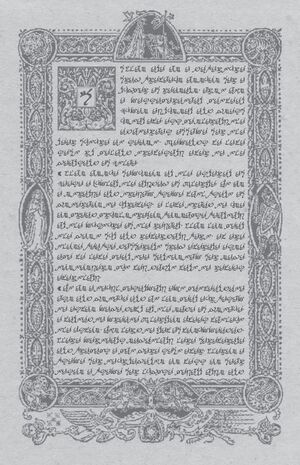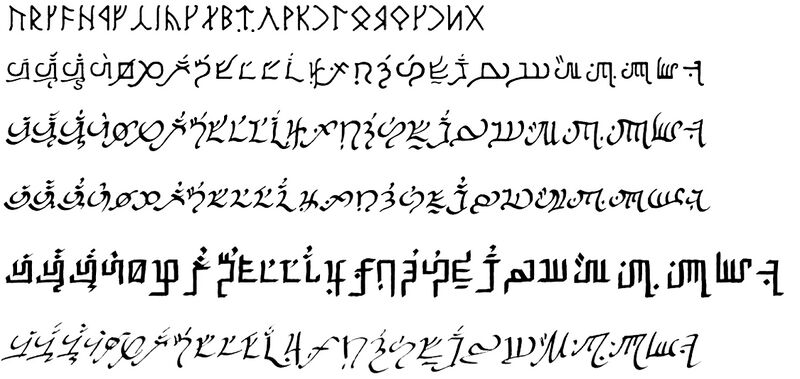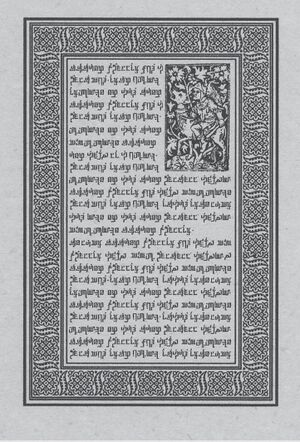The Written Word
| “ | On the different scripts of the Lakise alphabet, by Dean Gustus of The University of Berema. | ” |
The Lakise alphabet of north-western Lythia is written in many different scripts, or hands as some prefer to call them. It’s impossible to say which script is the oldest or most akin to the original one because over the centuries the scripts have mated and created offspring and inspired each other.
Northand[edit | edit source]
The Runic alphabet (fig. 1) of Ivinia, Orbaal and Harbaal has heavily influenced the way that the Lakise alphabet is portrayed in these parts of the world. Runic, which pre-dates the arrival of the Lakise alphabet to these harsh shores, is usually cut into stone or wood or written with a rush pen. The glyphs are simple in form and rhythm and the stroke of the rush pen gives very little in contrast, at least when in the hand of a layman. Northand (fig. 2) bears a clear resemblance to its older brother Runic, as we can see in the even strokes, straight lines and geometric forms. The disproportionate glyphs are the unquestionable trait of a bastard. The very shape of the script makes it impossible to write with a quill without great discomfort which explains why it’s almost never seen in civilised parts of the world.
Beremian Hand[edit | edit source]
The scholars of Emelrene are considered to be the best in the world and so it’s no wonder that they were the ones who created the most beautiful script of them all: the Beremian Hand. Now, 400 years after its first appearance, it has spread all over north-western Lythia and claimed its rightful place as the king of scripts. Its superiority has been acknowledged by both kings and priests who prefer Beremian Hand in their books and scrolls to other, less worthy, hands.
Circula[edit | edit source]
The flowing, speedy Circula script (fig. 4) is commonly used by litigants, merchants, scholars, nobles and others who require some, but not the highest, level of formality. It’s faster to write than Beremian Hand and more compact so one can lower the cost of vellum. Circula is simpler than Beremian Hand and so it requires fewer strokes to finish. The name circula comes from the script’s circular shapes. The script is generally rounder than Beremian Hand and the glyphs tend to return to themselves in the finishing strokes.
Circula is common all over the western kingdoms, Hârn and the cities of Harbaal.
Lankorian Blackhand[edit | edit source]
Lankor is the birthplace of this dark, fractured hand that is sprung from the austere minds of the Lankorians and reflects the heavy forests and mountains of their land. This script is only found in the kingdom of Lankor (fig. 5).
Blackhand is unique among the Lakise scripts. It is made up of vertical and horizontal angular strokes as opposed to the usual round and diagonal ones of other scripts. Because of this Blackhand is somewhat slower to write and demands more concentration from the scribe. However, a finely crafted page of tightly written Blackhand is indeed an impressive sight—some would even say intimidating.
Quickhands[edit | edit source]

This is not a clearly defined script as such, but rather the infinite range of hands used by people in their daily lives for diaries, letters, notes and other informal correspondence (fig. 6).
These vernacluar hands emphasize speed and care nothing for beauty or harmony. Sometimes they leave glyphs unfinished or make them part of the one before them. Quickhand is born out of the writers’ mind and soul and can be very eccentric—even to the point of being illegible to others.
- Magnusson, Lucas (2004). Thonahexus 5. pp. 2–3.

